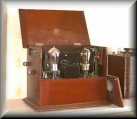TECHNICAL TERMS & SOME EXPLANATIONS - summary for examiners
Each student responsible for five episodes (student's own clump) = 25 minutes + trail + production and postproduction on part of the first five episodes. (Students do not script the first five episodes.) That is a total of some 31 minutes. Students also write up Critique. Further: web site, marketing, focus group meeting, drop-in script (for radio presenter when broadcast), copyright material logging, soap launch.
(1) CRITIQUE
(2) Process
(3) How you would bring your work to the next level.
(4) REFLECT about your process, product and theory
(5) You account for copyrightClump = the five episodes for which each student is responsible - scripting, production, post-production
Trail = one-minute advertisement for the soap - each student responsible for a trail.
Casting: Students have total responsibility for this. Teacher can intervene as Soap Editor to require changes. But responsibility for below average acting remains with radio students. Students are to display their talent as producers (the casting and business side of production) as well as being directors.
Scripting: Teacher can intervene as Soap Editor to require changes. Scripts have to conform to B.B.C. Producers' Guidelines on taste and decency (with a little latitude), legal aspects, copyright issues, diversity and impartiality, etc. No offensive swearing. Advertising - products can be named. Laws regulating broadcasting and libel apply.
Music choices: Aim is to use entertaining and ironic music choices - usually as music bridges (between scenes) and as underscoring music. The latter to add to the texture of the scene, mood, and sound picture (aural 'mise en scène').
SOME TECHNIQUES:
Approach - actor approaches the microphone and so the listener gets the impression that the character approaches the sound centre. Opposite - moving off, and moves off. Microphone positions are one (nearest) to five.
SIGNPOSTING:
technique for establishing the location at the beginning of a scene. This is done by effects, spot or FX, and often backed by description.ESTABLISH LOCATION FOR SCENE: Establish atmos for the scene (unless neutral atmos). Establish key FX - location identifier (if needed) - as seagull, rain, factory hooter, traffic, cathedral bells, crowd talking or shouting. Description (see below) is nearly always needed to twin with signposting.
Description - added words in the dialogue to fill in what is 'blind' for the listener. It is mostly of physical details, facial expressions, gestures and bodily action, and also of the location. Description needs to be so skilfully scripted that it is not obtrusive.
Perspective in the scene: (advice from the course site) Design your sound picture - usually around the protagonist (main character). Make use of an effective 'close-up' - near the end of a scene, you could bring your two characters (best with two) nearer the microphone - into position number 2, and so the last phrase of the dialogue is intimate - closer to the audience, and a 'close-up' shot.
ESTABLISH SOUND CENTRE AT THE TOP OF A SCENE:
By convention, the sound centre is established at the top of a scene by the first speaker, and this character is at the sound centre. This establishes a measure for all the other characters. We are 'with' or nearest the first character speaking. That helps us get the perspective of the sound picture in our 'view' as listeners.'we go with' (moving sound centre) - production technique of moving along with the characters as they walk, talking to each other. (Opposed to fixed sound centre)
Perspective - construction, width and depth of the sound picture. "Perspective" is the three-dimensional aspect of the sound picture (or scene) constructed.
the 'moving camera' - unusual technique. This is where within the same 'mise en scène', and within the same scene, the location changes during the dialogue - under special conditions. And it is best explained by the television equivalent - the 'moving camera' (where camera = microphone).
TECHNICAL PROBLEMS:
Blasting - the sound distorts because it has been recorded at too high a levelBalancing - the crucial requirement to balance the different elements in a scene correctly (as underscoring music under dialogue) convincingly ALSO the balancing of different scenes overall in an episode, so that a scene is not suddenly too loud or too soft. This is difficult to do successfully. (post-production)
Slurring words - poor voicing and articulation by an actor, so that a word is not heard properly, and is lost, and the listener is puzzled. (Directing)
Clustering - a character's voice sounds too alike another, and it is difficult or impossible for the listener to tell them apart. This is an especial problem with young women's voices (for various reasons). The cause is wrong casting in the mix of the characters overall. Solutions include using dialect and contrasting characters in pitch.
POST-PRODUCTION PROBLEMS on computer:
'spikies' - small spiky peaks which are blemishes on the audio. The cause is the computer the student working on, and often there is nothing can be done about it, but to start again from afresh with production. This may not be possible within the time and resources. If so - student not to be penalised for this.hiss - a similar problem occurring intermittently in the computers the students are working on. Sometimes correctable if time - see note above about 'spikies'.
See INDEX 'A' TO 'Z' (RADIO SOAP SITE)
See also 'Radio Drama - directing, acting, technical, learning & teaching, researching, styles, genres'. See INDEX to navigate also. Complete curriculum of scripts, techniques (acting & directing & post-production & genre styles), advice, sound files - effects and atmoses (with no copyright and so free to use), detailed script commentaries, etc.
Academic material on this site is  Alan Beck
is licensed under a Creative Commons Attribution-Non-Commercial-Share
Alike 2.0 UK: England & Wales License.
Alan Beck
is licensed under a Creative Commons Attribution-Non-Commercial-Share
Alike 2.0 UK: England & Wales License.
Learn about radio drama on this site along with my book - Beck, Alan, Radio Acting, London: A & C Black ISBN 0-7136-4631-4 Available on Amazon. CLICK HERE.
To the WELCOME PAGE for Alan Beck's sites. See more of Alan Beck's work.

Any opinions expressed in this site are the personal opinions of the owner of the site. IF YOU HAVE COMMENTS, PLEASE EMAIL TO : [email protected]

